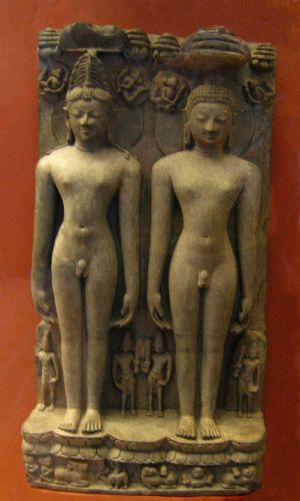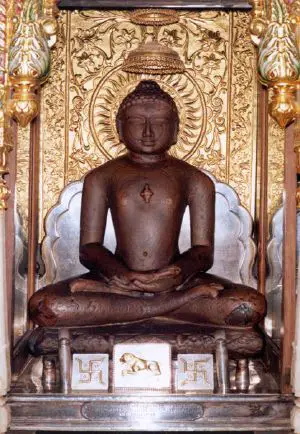Tirthankara
In Jainism, a Tirthankara ("Fordmaker") (also Tirthankara or Jina) is a human who achieves enlightenment (perfect knowledge), through asceticism. A Tirthankar becomes a Jina (after totally conquering anger, pride, deceit, desire, etc.). A Tirthankar is the founder of a "Tirth", a Jain community which acts as a "ford" across the "river of human misery".
After achieving enlightenment, a Tirthankar shows others the path to enlightenment. The Tirthankar's religious teachings form the Jain canons. The inner knowledge of all Tirthankars is perfect and identical in every respect, for the teachings of one Tirthankar do not contradict those of another. However, the degree of elaboration varies according to the spiritual advancement and purity of humans during that period. The higher the spiritual advancement and purity of mind, the lower the elaboration required.
At the end of his human life-span, a Tirthankar achieves liberation ('moksh' or 'nirvan'), ending the cycle of infinite births and deaths.
Jainism states time has no beginning or end. It moves like the wheel of a cart. There have been an infinite number of time cycles before our present era and there will be an infinite number of time cycles after this age. At the beginning of the twenty first century, we are approximately 2,530 years into the fifth era of the present half cycle.
Twenty four Tirthankars are born in each half cycle of time (that is forty eight in each full cycle), in this part of the universe. In our current (descending) half cycle of time, the first Tirthankar Rishabh Dev[citation needed], lived billions of years ago and attained liberation ('moksh' or 'nirvan') towards the end of the third era. The 24th and last Tirthankar was Mahavir Swami (599-527 B.C.E.), whose existence is a historically accepted fact. Digambaras believe that all twenty four Tirthankars were men but Svetambaras believe that the 19th Tirthankar, Malli Nath, was a woman.
The next Tirthankar in our part of the universe will be born at the beginning of the third era of the next (ascending) half cycle of time, in approximately 81,500 years.
As Tirthankars direct us to enlightenment, their statues are worshipped in Jain temples by Jains aspiring to achieve enlightenment. Tirthankars are not God or gods. Jainism does not believe in the existence of God in the sense of a creator, and gods are beings superior to humans but, nevertheless, not fully enlightened.
Particular Tirthankars

Depictions in various forms, including images, statues, etc., of the Tirthankaras are always represented as seated with their legs crossed in front, the toes of one foot resting close upon the knee of the other, and the right hand lying over the left in the lap. Only two are represented differently: that of Parsvanatha, the twenty-third, who has snake-hoods over him, and Suparsva, the seventh, who the Digambarashas depict with a smaller group of snake-hoods.
Digambara representations are quite nude, while those of the Svetambaras are clothed and decorated with crowns and ornaments. They are further distinguished from one another in representations by their attendant Yakshas and Yakshinis, as well as by their associated chihnas (cognizances) carved on the cushions of their thrones.
All but two of the Jains are ascribed to the Ikshvaku family (or Kula or Kul, which in Sanskrit means "heart community" or "intentional/chosen community/family"). Munisuvrata, the twentieth, and Neminatha, the twenty-second, were of the Harivamsa race.
All but Rishabha received diksha (consecration) and jnana (complete enlightenment) at their native places. Rishabha became a Kevalin at Purimatala, Nemi at Girnar, and Mahavira at the Rijupaluka river. Twenty Tirthankaras died or obtained moksha (deliverance in bliss) on Sameta Sikhara. However Rishabha, the first, achieved nirvana on the Kailasa Mountain of the Himalayas; Vasupujya died at Champapuri in north Bengal; Neminatha on Mount Girnar; and Mahavira, the last, at Pavapur.
Twenty-one of the Tirthakaras are said to have attained Moksha in the Kayotsarga posture; Rishabha, Nemi; and Mahavira on the padmasana (lotus throne).
Narration Chart of 24 Tirathankars
The following particulars for each Arhat are given below:
| Tirthankar | Heaven | Birthplace; Consecration |
Parents | Complex | Symbol | Height | Age | Tree | Attendant spirits |
Male disciple; Female disciple |
|---|---|---|---|---|---|---|---|---|---|---|
| I. Lord Rishabha (Adinath) | Sarvarthasiddha | Vinittanagari; Purimatala |
Nabhiraja by Marudeva |
golden | bull or ox | 500 dhanusha (poles) |
8,400,000 purva (great years) |
Vata (banyan) | Gomukha and Chakresvari |
Pundarika; Brahmi |
| II. Ajitnath | Vijayavimana | Ayodhya; Sammet Shikharji |
Jita['s]atru by Vijayamata |
golden | elephant | 450 dhanusha | 7,200,000 purva | ['S]ala (Shorea robusta) |
Mahayaksha and Ajitabala; or Rohi[n.]i |
['S]i[.m]hasena; Phalgu |
| III. Sambhavanath | Uvarimagraiveka | Savathi; Sravasti |
Jitari by Senamata |
golden | horse | 400 dhanusha | 6,000,000 purva | Prayala (Buchanania latifolia) |
Trimukha and Duritari; or Prajnapti |
Charu; Syama |
| IV. Abhinandannath | Jayantavimana | Ayodhya; Sammet Shikharji |
Sambararaja by Siddhartha |
golden | monkey | 350 dhanusha | 5,000,000 purva | Priyangu (Panicum italicum) |
Nayaka and Kalika; or Yakshesvara and Vajrasrinkhala |
Vajranabha; Ajita |
| V. Sumatinath | Jayantavimana | Ayodhya; Sammet Shikharji |
Megharaja by Mangala |
golden | curlew or red goose |
300 dhanusha | 4,000,000 purva | Sala | Tumburu and Mahakali; or Purushadatta |
Charama; Kasyapi |
| VI. Padmaprabha | Uvarimagraiveka | Kausambi; Sammet Shikharji |
Sridhara by Susima |
red | lotus | 250 dhanusha | 3,000,000 purva | Chhatra | Kusuma and Syama; or Manovega or Manogupti |
Pradyotana; Rati |
| VII. Suparshvanath | Madhyamagraiveka | Varanasi; Sammet Shikharji |
Pratish[t.]haraja by P[r.]ithvi |
golden or emerald |
swastika | 200 dhanusha | 2,000,000 purva | Sirisha (Acacia sirisha) |
Matanga and Santa; or Varanandi and Kali |
Vidirbha; Soma |
| VIII. Chandraprabha | Vijayanta | Chandrapura; Sammet Shikharji |
Mahasenaraja by Lakshmana |
white | moon | 150 dhanusha | 1,000,000 purva | Naga | Vijaya and Bhrikuti; or Syama or Vijaya and Jvalamalini |
Dinna; Sumana |
| IX. Pushpadanta | Anatadevaloka | Kanandinagari; Sammet Shikharji |
Sugrivaraja by Ramarani |
white | Crocodile | 100 dhanusha | 200,000 purva | Sali | Ajita and Sutaraka; or Mahakali |
Varahaka; Varuni |
| X. Sheetalnath | Achyutadevaloka | Bhadrapura or Bhadilapura; Sammet Shikharji |
Dridharatha-raja by Nanda |
golden | Kalpavriksha or ficus religiosa |
90 dhanusha | 100,000 purva | Priyangu | Brahma and Asoka; or Manavi |
Nanda; Sujasa |
| XI. Shreyansanath | Achyutadevaloka | Simhapuri; Sammet Shikharji |
Vishnuraja by Vishna |
golden | rhinoceros | 80 dhanusha | 8,400,000 common years | Tanduka | Yakshet and Manavi; or Isvara and Gauri |
Kasyapa; Dharani |
| XII. Vasupujya | Pranatadevaloka | Champapuri; Sammet Shikharji |
Vasupujya by Jaya |
ruddy | female buffalo | 70 dhanusha | 7,200,000 years | Patala (Bignonia suaveolens) |
Kumara and Chanda; or Gandhari |
Subhuma; Dharani |
| XIII. Vimalnath | Mahasaradevaloka | Kampilyapura; Sammet Shikharji |
Kritavarmaraja by Syama |
golden | pig | 60 dhanusha | 6,000,000 years | Jambu (Eugenia jambolana) |
Shanmukha and Vidita; or Vairo[t.]i) |
Mandara; Dhara |
| XIV. Anantnath | Pranatadevaloka | Ayodhya; Sammet Shikharji |
Simhasena by Suyasah or Sujasa |
golden | porcupine | 50 dhanusha | 3,000,000 years | Asoka (Jonesia asoka) |
Patala and Ankusa; or Anantamati |
Jasa ; Padma |
| XV. Dharmanath | Vijayavimana | Ratnapuri; Sammet Shikharji |
Bhanuraja by Suvrita |
golden | vajra | 45 dhanusha | 1,000,000 years | Dadhiparna (Clitoria ternatea) |
Kinnara and Kandarpa; or Manasi |
Arishta; Arthasiva |
| XVI. Shantinath | Sarvarthasiddha | Gajapura or Hastinapuri; Sammet Shikharji |
Visvasena by Achira |
golden | deer | 40 dhanusha | 100,000 years | Nandi (Cedrela toona) |
Garuda and Nirvani; or Kimpurusha and Mahamanasi |
Chakrayuddha; Suchi |
| XVII. Kunthunath | Sarvarthasiddha | Gajapura; Sammet Shikharji |
Suraraja by Srirani |
golden | goat | 35 dhanusha | 95,000 years | Bhilaka | Gandharva and Bala; or Vijaya |
Samba; Damini |
| XVIII. Aranath | Sarvarthasiddha | Gajapura; Sammet Shikharji |
Sudarsana by Devirani |
golden | fish or Pisces |
30 dhanusha | 84,000 years | Amba (Mango) |
Yaksheta and Dhana; or Kendra and Ajita |
Kumbha; Rakshita |
| XIX. Mallinath | Jayantadevaloka | Mathura; Sammet Shikharji |
Kumbharaja by Prabhavati |
blue | jar or Kalasa | 25 dhanusha | 55,000 years | Asoka | Kubera and Dharanapriya; or Aparajita |
Abhikshaka; Bandhumati |
| XX. Munisuvrata | Aparajita-devaloka | Rajagriha; Sammet Shikharji |
Sumitraraja by Padmavati |
black | tortoise | 20 dhanusha | 30,000 years | Champaka (Michelia champaka) |
Varuna and Naradatta; or Bahurupini |
Malli; Pushpavati |
| XXI. Nami Natha | Pranatadevaloka | Mathura; Sammet Shikharji |
Vijayaraja by Viprarani |
yellow; or emerald |
blue water-lily or blue lotus | 15 dhanusha | 10,000 years | Bakula (Mimusops elengi) |
Bhrikuti and Gandhari; or Chamundi |
Subha; Anila |
| XXII. Neminatha | Aparajita | Sauripura and Ujjinta (Ujjain); Mount Girnar (Girnarji) |
3 by Senamata |
black | conch | 10 dhanusha | 1,000 years | Vetasa | Gomedha and Ambika; or Sarvahna and Kushmandini |
Varadatta; Yakshadinna |
| XXIII. Parshva | Pranatadevaloka | Varanasi; Sammet Shikharji |
Asvasenaraja by Vamadevi |
blue | snake | 9 hands or cubits | 100 years | Dhataki (Grislea tomentosa) |
Parsvayaksha or Dharanendra and Padmavati |
Aryadinna; Pushpachu[d.]a |
| XXIV. Mahavira | Pranatadevaloka | Kundagrama or Chitrakuta; Rijupaluka |
Siddhartharaja, Sreyansa or Yasasvin by Trisala Vidchadinna or Priyakarini |
yellow | lion | 7 hands or cubits | 72 years | teak | Matamga and Siddhayika |
Indrabhuti; Chandrabala |
See also
- Jainism
- Deshna
External links
fr:Tîrthankara it:Tirthamkara pt:Tirthankara
Credits
New World Encyclopedia writers and editors rewrote and completed the Wikipedia article in accordance with New World Encyclopedia standards. This article abides by terms of the Creative Commons CC-by-sa 3.0 License (CC-by-sa), which may be used and disseminated with proper attribution. Credit is due under the terms of this license that can reference both the New World Encyclopedia contributors and the selfless volunteer contributors of the Wikimedia Foundation. To cite this article click here for a list of acceptable citing formats.The history of earlier contributions by wikipedians is accessible to researchers here:
The history of this article since it was imported to New World Encyclopedia:
Note: Some restrictions may apply to use of individual images which are separately licensed.
